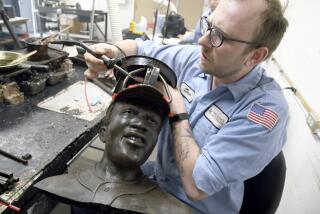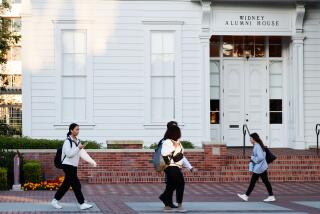They’re hoping Bruce Lee can bust on through
SEATTLE — When she closes her eyes, college sophomore Courtney Ioane can visualize the statue of Bruce Lee that she wants erected on the University of Washington campus.
It is bronze and life-size -- not so big that it dominates the area but substantial enough to be noticed. And the legendary fighter and movie star would not be punching or kicking but sitting in a meditative pose.
“Bruce Lee was more than a martial artist,” said Ioane, 20. “He also had an amazing philosophy of life. He’s a cultural icon recognized all over the world -- except on this campus,” where Lee studied for three years in the early 1960s.
Ioane and 20 other University of Washington students have collected more than 1,000 signatures -- including from nearly all members of the men’s and women’s basketball teams -- as part of the effort to build a monument to Lee.
She said the statue would help represent the campus’ diversity, something that is absent in the school’s collection of public art. Nearly all of the several dozen statues and busts on the sprawling 700-acre campus are of white men, including the school’s namesake, George Washington.
Of the school’s 28,570 undergraduates, more than 35% are minorities. One in four students is Asian American. Ioane, from Spokane, Wash., is half Samoan.
University officials have remained noncommittal on the project, and at least one spokesman questioned whether Lee’s accomplishments merited a memorial on a college campus.
If the students succeed, the statue would add to a growing list of Lee tributes worldwide. In China, streets have been named and memorials erected in his honor. A massive Lee theme park is under construction in Shunde, China. In Bosnia, a bronze Lee statue was unveiled in 2005 as a symbol of healing and unity.
Lee was born in San Francisco and grew up in Hong Kong. His movies raised martial arts to new levels of popularity and became a source of pride for Asians and Asian Americans who had been commonly depicted as weak in the popular media.
Lee’s 1973 movie “Enter the Dragon” was one of the highest-grossing films of that year, and to date it has grossed more than $200 million worldwide. Because he is routinely listed as one of the most recognizable pop culture figures of the 20th century, it surprises some observers that Lee made only four movies.
He died at age 32 of a cerebral edema a few months after completing “Enter the Dragon.”
He is buried in Seattle.
“I’m not for taking any of the existing statues down,” said Jamil Suleman, referring to the campus’ memorials to white men. “I’m just for putting up statues that represent us.”
Suleman, 23, graduated from the University of Washington this year. He was born in Africa to East Indian parents. The idea for a Lee monument was his. To begin the process, Suleman formed a group on campus called Bruce Lee Dedication.
Suleman often gave informal tours of the school’s various monuments and art displays. On a recent afternoon, he stood below a towering statue of George Washington off the school’s main plaza.
Gesturing to the monument, Suleman said Washington represented one version of history, but not his or that of Native Americans or Africans.
“You won’t find our history taught here,” he said. “You have to search for it yourself.”
Walking through campus, Suleman pointed out artistic representations of William Shakespeare, Immanuel Kant, Isaac Newton and Benjamin Franklin.
In front of Husky Stadium there’s a statue of Jim Owens, the university’s football coach from 1957 to 1974.
“Do you see Gandhi anywhere? Or Martin Luther King or Malcolm X?” Suleman asked.
At one point, Suleman stopped in front of an enormous bronze bust of Norwegian composer Edvard Grieg, who died in 1907. The centerpiece of Grieg Garden, the bust was donated in 1917 by the Scandinavian Societies of the Northwest and Alaska.
Grieg, Suleman noted, never attended the University of Washington.
Although Lee didn’t graduate, he attended the university for three years and often taught martial arts classes on the lawns near the student union. Lee took drama and philosophy classes, and he met his wife, Linda Cadwell, on campus. Like many of Lee’s students, Cadwell adopted his philosophies and his fighting techniques.
One of Lee’s most quoted lines had to do with fluidity and adaptability, which pertained to fighting but also to any process that involved conflict.
“Be formless, shapeless -- like water,” he once said. “If you put water into a cup, it becomes the cup. You put water in a bottle, it becomes the bottle. You put it into a teapot, it becomes the teapot. Water can flow, and it can crash. Be like water.”
Norm Arkans, a spokesman for the university, said proposals for public art must go through a lengthy, often years-long process.
“It’s not random, it’s not willy-nilly,” he said.
The proposal, he said, would have to emerge from a university department, go through numerous planning committees and gain the approval of the school’s administration.
Even if Suleman’s group goes through all the hoops, nothing is guaranteed.
“One has to ask oneself, in terms of receiving individual recognition on campus, what claim to fame did Bruce Lee have?” Arkans said. “He became a famous personage in one genre of movies. I don’t know if he had other claims to fame.”
But Arkans added that the university would consider the idea.
“As far as I know, nothing has been submitted yet,” he said. “It’s hard to have a response to something we haven’t seen.”
And it’s not entirely true that minorities are unrepresented on campus, Arkans said.
In 2005, the university unveiled a student-created artwork called “Blocked Out,” which features a small rolling lawn on which a giant ear is built from stones.
On the other side of the lawn stands a granite cube -- simulating an auction block where slaves were sold -- imprinted with bare footprints facing the ear, as if an unseen person is finally being heard.
A plaque reads: “Dedicated to those who were excluded from the home they were exploited to create.”
Critics of “Blocked Out” say that it is too abstract and that most passers-by don’t know what to make of it.
A statue of Lee, however, would be instantly recognizable, Ioane said.
“The university throws around the word ‘diversity’ a lot,” she said. “We’re trying to find out whether they really mean it or they’re just talking.”
More to Read
The biggest entertainment stories
Get our big stories about Hollywood, film, television, music, arts, culture and more right in your inbox as soon as they publish.
You may occasionally receive promotional content from the Los Angeles Times.










